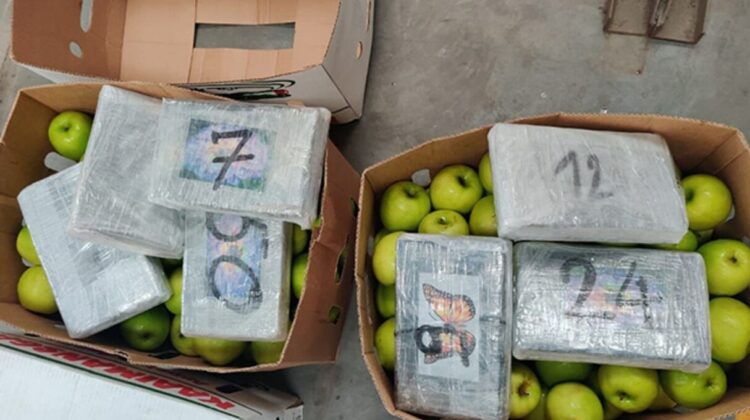
High-value narcotics intercepted at Mumbai Ports
MUMBAI : On October 6, 2022, officials of the Directorate of Revenue Intelligence (DRI)’s Mumbai Zonal Unit (MZU) intercepted a shipping container at the busy Nhava Sheva Port, Navi Mumbai. The container appeared to be a regular one, just one among several that had arrived from abroad carrying imported goods. Its declarations allegedly stated that it was carrying a consignment of green apples and pears from South Africa. A closer scrutiny however revealed that the delectable fruits were just cover props to deceive the examiners’ first glance.
Deeper inside the boxes, the DRI officials found something less innocuous than green apples: fifty bricks made of a material that, on testing, turned out to be high-quality cocaine. Each brick weighed around 1 kg, and the 50.23 kg of cocaine was worth a whopping ₹502 crore in the international illicit market. The seizure of the cocaine, one of the most-sought-after and harmful drugs globally, was among the largest in the country in recent years.
But the seizure was no flash in the pan. According to sources from the agency, in 2022-23, DRI’s MZU team made record seizures of high-value narcotics like cocaine, heroin and synthetic drugs, including methamphetamine. The figures were far higher than corresponding seizures in 2020-21 and 2021-22. “Such seizures over the years are the result of meticulous intelligence and execution,” said an agency source. The data for 2023-24 will be available after April 2024.
MZU officials had made another large seizure of high-value contraband barely a week before the cocaine seizure of October 2022. On September 30, the officials had intercepted an imported consignment of the popular Valencia oranges, known for sweetness and flavour, which had arrived in a shipping container from South Africa at the same Nhava Sheva Port.
A thorough examination of the fruit consignment on a truck, which was intercepted shortly after it exited a cold storage in Vashi, yielded a virtual bouquet of high-value contraband—nine kg of high-purity cocaine and 198 kg of the synthetic narcotic methamphetamine (street name, ‘ice’), both adding up to a combined worth of ₹1,476 crore. The importer, who had allegedly imported this consignment as well as the cocaine consignment of October 6, was arrested under the provisions of the Narcotic Drugs and Psychotropic Substances (NDPS) Act, 1985.
In 2022-23, the MZU seized narcotics weighing a total of 864.44 kg, estimated to be worth ₹4,345.92 crore in the illicit market. This was around six times more in value than the seizures made by the agency in 2020-21, which was estimated to be ₹669.63 crore. Similarly, the 2022-23 seizures were greater in value by around over 1.8 times to the corresponding seizures made in 2021-22 in terms of their estimated value. The 2021-22 seizures were valued at around ₹2,357.24 crore.
The total quantity of the 2020-21 seizures, at 2,485.05 kg, was around 2.8 times larger than the 2022-23 seizures, and yet the latter was greater in value. Agency sources said this was because of the preponderance of high-value and highly addictive and harmful narcotics such as cocaine, heroin and a range of synthetic drugs. The same trend can be seen when one compares MZU’s seizures of 2021-22 with the corresponding figures of 2022-23. At 3,851.41 kg, the seizures of 2021-22 were around 4.4 times more than those of 2022-23, and yet the latter’s value was greater due to the increased presence of high-value drugs.
When asked about the record seizures of high-value narcotics, especially during last year, a DRI source said, “The DRI is always vigilant and does its utmost to seize contraband, including narcotics, to strike at the core of trafficking networks and their manufacturing-supply capabilities. The seizures of high-value narcotics have increased in Mumbai of late for one reason: the global shift in the method of trafficking. Narcotics trafficking has shifted to trade-based sea routes, which allows smuggling in large quantities and the possible concealment of contraband among legitimate goods. In comparison, using couriers to traffic narcotics via the air route has its limitations—the quantity would be much smaller, from a few grams to a few kilograms.”

